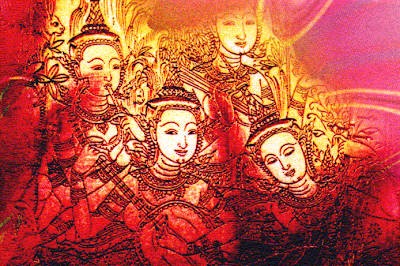
Models wearing body painted art by John Vargas from the United States, right, and Jinny Houle from Canada during the 2008 World Body Painting Festival in Daegu, South Korea, Friday, Aug. 29, 2008 (AP Photo/Ahn Young-joon).
Devas are "deities, "divinities," or "godlings" -- luminous body entities born as a result of skillful karma. Most of the 31 Planes of Existence are inhabited by different grades of devas. On the human plane, bhumi-devas are "earth angels," "faeries," "sylphs," and "dryads."
Devas are "deities, "divinities," or "godlings" -- luminous body entities born as a result of skillful karma. Most of the 31 Planes of Existence are inhabited by different grades of devas. On the human plane, bhumi-devas are "earth angels," "faeries," "sylphs," and "dryads."
They live in, above, or dependent on trees. Judging by artists renditions over many centuries, they are similar to young girls with delicate facial features and waifish (or Rubenesque, pre-Raphaelite) bodies.

They inhabit sylvan locations, ocean depths, mountain ranges, and are often found (or at least worshiped) at the confluence of rivers, waterfalls, places of immense natural beauty, and in "enchanted forests," which is only to say "perceived to be inhabited by supernatural beings."

There are, of course, celestial devas in both the Fine Material World as well as the Immaterial Planes. Like brahmas ("gods"), devas are glorious, radiant, resplendent and marked by signs of beauty. They, however, differ one from the other in terms of radiance, longevity, beauty, influence, powers, wisdom, and fortune. This is because all devas are still bound by karma.

In lower heavenly worlds (deva-lokas), when a being is reborn, it is referred to as a devaputra, literally a "son of god." Of course, it's not necessarily a "son," just a being born among devas, much as one born in this world might be called a "son of man." God (Maha Brahma, or "Great Brahma") has a retinue, and beings reborn into that retinue (i.e., "angels") would be devaputras rather than simple inhabitants of that heavenly realm (devas).
There they inhabit celestial mansions, vimanas (UFO-style platforms that are both home and vehicle) or palaces based on their karma. Female devas (devis) are also known as "celestial nymphs."

Lesser celestial devas have a chief or king known as Sakka. However, it is important to note that none of the named characters in this cosmology are individuals so much as posts or positions occupied (through karma) by individuals. Nor are they unique, but rather features of countless world-systems spreading out in all directions.
It is not difficult to make obvious connections to other world-religions. This view of devas -- living in sport, enjoying powers and beauty but plagued by petty jealousies and exploits -- is in line with Indian, Greek, Roman, Celtic, and Pagan pantheons. (Even monotheistic traditions understand that while there may be one ultimate godhead, God, or source, it has countless expressions).
Finally, since devas are superior to humans in many ways, the Buddha is frequently eferred to as a "teacher of gods and men [i.e., devas and humans]." More devas made spiritual attainments than humans even though only human realms give rise to buddhas.
In light of what is known of devas, and inasmuch as artists have acquainted us with bhumi-devas and lower celestial-devas, the following incarnations may suggest the extraordinary results of karma. (Noting that our bodies are results of our past karma).






































































































































































































































No comments:
Post a Comment